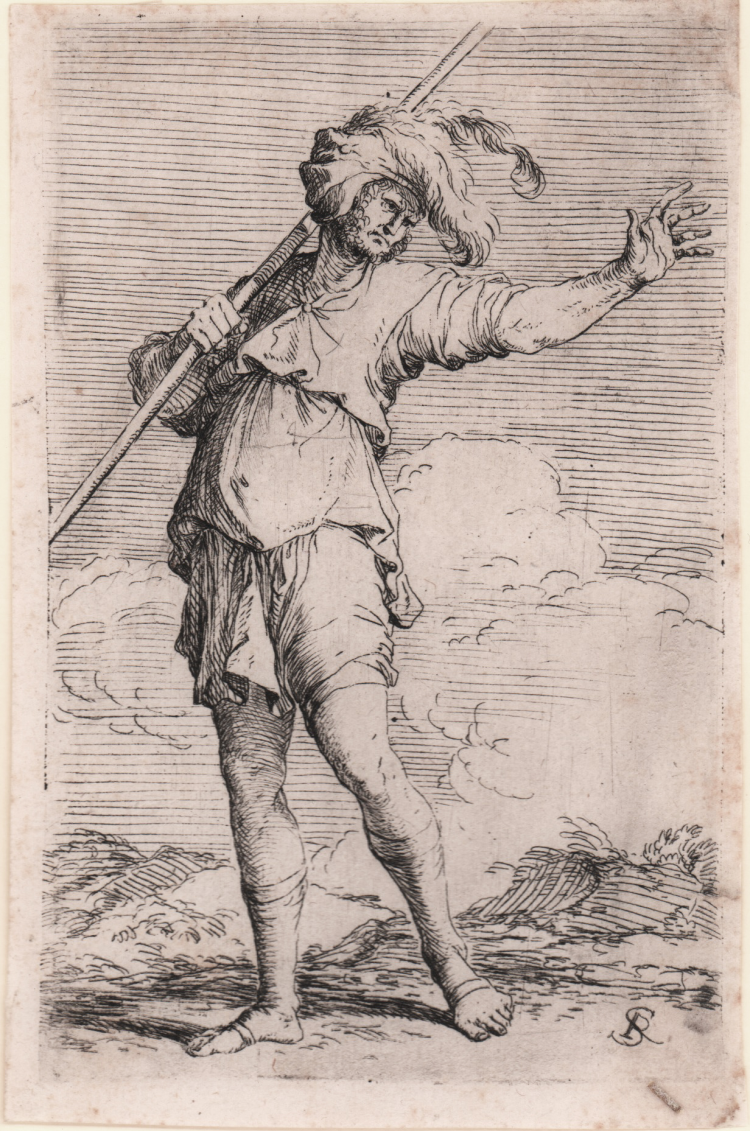



| Reference: | S24603 |
| Author | Salvator ROSA |
| Year: | 1656 ca. |
| Measures: | 90 x 140 mm |


| Reference: | S24603 |
| Author | Salvator ROSA |
| Year: | 1656 ca. |
| Measures: | 90 x 140 mm |
Etching and drypoint, circa 1656/8, monogrammed in plate.
From the series known as Diverse Figure.
Beautiful proof, rich in tone, impressed on contemporary laid paper, with thin margins, in excellent condition. Example of the second state, sjowing the Rosa’s monogram; first-state proofs, where they exist, are unmonogrammed and known in only one copy.
Known as Diverse Figure or Figurine, they are without doubt the most famous graphic work of Salvator Rosa. Already at that time it was considered a model for young artists, and was copied several times both in Italy and abroad. In the figures of soldiers in exotic or invented costumes, Rosa develops a theme treated by many engravers such as Callot, Della Bella and Filippo Liagno, with whom he had a close relationship, and through whom he probably came to know the subjects of the fifteenth-century Lansquenets by Dürer and Urs Graf.
A letter from the artist to his friend Ricciardi dated 1656 allows the series to be dated with certainty to the period 1656/8. Bartsch lists the work as consisting of 61 prints, while Rotili and Wallace describe some rare variants of the subjects, later never included in the series, bringing the number of Figurine to 72.
|
Bartsch 33 II/III; Wallace 21 II/II..
|
Salvator ROSA (Napoli 1615 - Roma 1673)
|
Like Testa, Castiglione and Della Bella, Salvator Rosa considered the art of engraving the best technique to express his talent and, it is not by chance that he is considered, together with the already mentioned artists, one of the protagonists of Italian seventeenth-century art.
Rosa was an extremely eclectic person; his main models in art were the classicism of Carracci, the naturalism of Ribera, the contemporary Roman painting and the ancient world.
From the latter in particular, Rosa drew inspiration for his engravings, whose subjects come from the old Stoic philosophy, with the glorification of virtues though allegories. We have also to consider his passion for esotericism, which inspired him with pictorial compositions with necromancy.
His technique and total command of etching enabled his prints to be appreciated even from his contemporaries, copied by them and highly requested by collectors.
|
|
Bartsch 33 II/III; Wallace 21 II/II..
|
Salvator ROSA (Napoli 1615 - Roma 1673)
|
Like Testa, Castiglione and Della Bella, Salvator Rosa considered the art of engraving the best technique to express his talent and, it is not by chance that he is considered, together with the already mentioned artists, one of the protagonists of Italian seventeenth-century art.
Rosa was an extremely eclectic person; his main models in art were the classicism of Carracci, the naturalism of Ribera, the contemporary Roman painting and the ancient world.
From the latter in particular, Rosa drew inspiration for his engravings, whose subjects come from the old Stoic philosophy, with the glorification of virtues though allegories. We have also to consider his passion for esotericism, which inspired him with pictorial compositions with necromancy.
His technique and total command of etching enabled his prints to be appreciated even from his contemporaries, copied by them and highly requested by collectors.
|